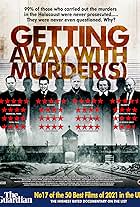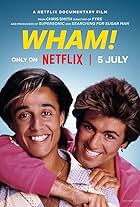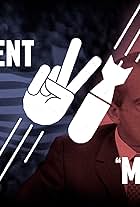Advanced search
- TITLES
- NAMES
- COLLABORATIONS
Search filters
Enter full date
to
or just enter yyyy, or yyyy-mm below
to
to
to
Exclude
Only includes titles with the selected topics
to
In minutes
to
1-26 of 26
- 99% of those who carried out the murders in the Holocaust were never prosecuted. Why not?
- A glittery nightclub in 1920s Berlin becomes a haven for the queer community in this documentary exploring the freedoms lost amid Hitler's rise to power.
- Through archival interviews and footage, George Michael and Andrew Ridgeley relive the arc of their Wham career, from '70s best buds to '80s pop icons.
- It was arguably the deadliest conference in human history. The topic: plans to murder 11 million Jews in Europe. The participants were not psychopaths, but educated men from the SS, police, administration and ministries. The invitation to the meeting at Wannsee came from Reinhard Heydrich, head of the Reich Security Main Office. The Wehrmacht's campaigns of conquest in Eastern Europe marked the beginning of the systematic murder of Jews in Poland and the Soviet Union. In mid-September 1941, Hitler made the decision to deport all Jews from Germany to the East. Although there had been transports before, Hitler's order represented a further escalation in the murderous decision-making process. Persecution and discrimination had been part of everyday life since 1933. But as a result, the living conditions for the Jews in the Third Reich became even more difficult, among them the Berlin Jew Margot Friedländer, born in 1921, and the Chotzen family.
- World War II historian John Curatola rates eight battle scenes in movies and television for realism. He discusses the accuracy of World War II battle scenes from "Saving Private Ryan" (1998), starring Tom Hanks; "Dunkirk" (2017), featuring Tom Hardy; and "Band of Brothers" S1E3 (2001), with Damian Lewis. He also comments on the weaponry used in "Fury" (2014), with Brad Pitt; "Patton" (1970); and "Enemy at the Gates" (2001). Curatola analyzes the tactics displayed in "The Forgotten Battle" (2020) and "Defiance" (2008), starring Daniel Craig.
- With his blue eyes, blond hair and youthful smile, Hardy Krüger conquered the German public in the 1950s, before making his way to Hollywood. Born in Berlin in 1928, he was conscripted into the Wehrmacht in the final days of the Second World War, a traumatic experience that would affect him for the rest of his life. He then began a career as an actor under the direction of directors such as Alfred Weidenmann, Helmut Weiss or Rudolf Jugert, before being noticed outside his native country. Polyglot, he speaks fluently in French and English, he became known to the French public in "Un cab pour Tobrouk", where he played opposite Lino Ventura and Charles Aznavour, and conquered America with "Hatari!", by Howard Hawks.
- Since the outbreak of global corona pandemic, the number of anti-Jewish content has increased on the Internet and social media. Researchers see a connection between online radicalization and anti -Semitic violence - and also attacks. "Jud Süß 2.0" documents the visual roots of this new anti-Semitism and takes a historical look back at the image worlds of National Socialism: The sterotypes, conspiracy stories and enemy images of perfidious Nazi propaganda films such as "Jud Süß" or "The Eternal Jew" in the digital Mainstream of today?
- Marine biologist and doctoral student Amani Webber-Schultz rates 10 shark attacks in movies and TV shows, such as "Jaws," for realism.
- Armor officer and military tank historian Nicholas Moran rates eight tank battles in movies, such as "Saving Private Ryan" and "Fury," for realism.
- Trauma surgeon and Navy veteran Dr. Peter Rhee rates nine battlefield medical scenes in movies and TV for realism. Rhee breaks down the historical accuracy of treating gunshot wounds during World War II in "Band of Brothers" (2001) and "Saving Private Ryan" (1998), starring Tom Hanks. He looks at the realism of battlefield surgeries in "M*A*S*H" (1979), "Code Black" (2016), and "Master and Commander: The Far Side of the World" (2003), featuring Russell Crowe. He also discusses the reality of treating other battle and trauma injuries in "The Punisher" (2017); "Grey's Anatomy" S6E18 (2010); "John Wick: Chapter 3 - Parabellum," starring Keanu Reeves; and "Rambo III" (1988), starring Sylvester Stallone.
- Frederick I, called "Barbarossa", fought for "the honor of the empire" - as king of Germany, Burgundy and Italy and as emperor of the Roman Empire.
- 1982– 52m6.2 (10)TV Episode
- 202145m8.3 (18)TV EpisodeHatred and the desire for revenge smoldered in the minds of many Germans after WW1. Many Germans believe that the Jews are the cause of many problems.
- 202145m8.4 (15)TV EpisodeAs Hitler sat in prison after the Nazi's failed putsch of Nov 1923 he wrote "My Struggle". Discover how the Nazi movement can use democracy's tolerance in Germany to achieve a comeback with agitation and violence.
- 202145m8.2 (10)TV EpisodeThe defeat at Stalingrad in 1943 was the turning point of the war and convinced the Nazi leadership to intensify their terror and propaganda campaigns, a horrific chapter of the Holocaust begins with the death marches of surviving concentration camp prisoners from the battlefields to the Reich.
- 202146m8.3 (11)TV EpisodeWhen the war ends in 1945 the violence is not over. The survivors and the winners want to blame the Germans. The reckoning with National Socialism is ambivalent.
- Two antiwar protests in the fall of 1969 cause President Richard Nixon to cancel his "madman" plans for a massive escalation of the U.S. war in Vietnam.
- 2023– 53mTV Episode

















